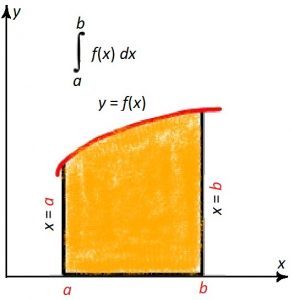Definite Integrals
In Geometry, we know how to calculate the area of a triangular plot of land.
We can also find the area of the plot, if it is in the shape of a rectangle or a Square.
All the shapes mentioned above (triangle, rectangle, square) are regular shapes, whose area can be found out by the known results called formulas.
Now, if we are given a shape which is not regular or standard one, then how do we find its area? We try to approximate its area by associating it with regular shapes.
For finding the area of such irregular shapes, area enclosed between two geometrical shapes we make use of Definite Integrals.
Here, we introduce the concept of Definite Integrals.
- A definite integral is denoted by
f(x)dx where a is called the lower limit of the integral & b is called the upper limit of the integral.
f(x)dx denotes the area of the region bounded by the curve y = f(x), the ordinates x = a, x = band the x-axis.

- Since the definite integral denotes the area enclosed, hence its value is always definite or fixed. So, it is called definite integral.
- Relation between Indefinite & definite integral.
If f(x) be a continuous function defined on the closed interval [a, b] & F(x) is its antiderivative i.e. f(x)dx = F(x) , then
f(x)dx =
= F(b) – F(a)
The above statement is called the Second fundamental Theorem of integral calculus.
Note: While evaluating a definite integral the Constant of Integration, C disappears at the end and hence its effect is nullified. So, we do not write the constant of integration while evaluating a definite integral.
Now let’s consider some examples on definite integrals .
Example 1: Evaluate the definite integral:dx
Let F(x) = dx =
+ x =
+x
dx =
= F(2) – F(0)
= –
=
– 0 =
Note: The constant of Integration is not written here, as it does not change the final value of the definite integral.
Example 2: Evaluate:
dx
Let F(x) = dx =
+
=
+
dx =
= F(1) – F(-1)
= –
= e +
–
–
e – = e –
Example 3: Evaluate:
dx
Let F(x) =
dx =
dx
=
dx –
dx =
– log |x| =
– log|x|
dx =
= F(5) – F(1)
= –
=
–
= – log|5| + log|1| =
– log|5| + 0 =
– log|5|
Example 4: Evaluate:
dx
Let F(x) = dx =
dx
=
dx = 3
dx + 4
CosecxCotx
= -3Cotx – 4Cosecx
dx =
= F
– F
–
= (-3(0)-4(1)) –
= (0 – 4) – = 4 + 3 +4
= -1 +4
Example 5: Evaluate dx
Let F(x) =dx
= 3
dx – 2
xdx + 7
dx = 3
– 2
+ 7
+C
= –
+
=
–
+
x
dx =
= F(4) – F(1)
= –
= –
= 48 + 98 =
=
Check Point
Evaluate the following definite integrals:
(x + 1)dx
dx
dx
(x – 1)(x – 2)dx
dx
Answer Key
(x + 1)dx =
dx =
dx = 7e +19
(x – 1)(x – 2)dx =
dx =
Personalized Online Tutoring
eTutorWorld offers affordable one-on-one live tutoring over the web for Grades 2-12, Test Prep help for Standardized tests like SCAT, CogAT, SSAT, SAT, ACT, ISEE and AP. You may schedule online tutoring lessons at your personal scheduled times, all with a Money-Back Guarantee. The first one-on-one online tutoring lesson is always FREE, no purchase obligation, no credit card required.
For answers/solutions to any question or to learn concepts, take a FREE Demo Session.
No credit card required, no obligation to purchase.
Just schedule a FREE Sessions to meet a tutor and get help on any topic you want!
Pricing for Online Tutoring
| Tutoring Package | Validity | Grade (1-12), College |
|---|---|---|
| 5 sessions | 1 Month | $139 |
| 1 session | 1 Month | $28 |
| 10 sessions | 3 months | $269 |
| 15 sessions | 3 months | $399 |
| 20 sessions | 4 months | $499 |
| 50 sessions | 6 months | $1189 |
| 100 sessions | 12 months | $2249 |
IN THE NEWS

Our mission is to provide high quality online tutoring services, using state of the art Internet technology, to school students worldwide.
Online test prep and practice
SCAT
CogAT
SSAT
ISEE
PSAT
SAT
ACT
AP Exam
Science Tutoring
Physics Tutoring
Chemistry Tutoring
Biology Tutoring
Math Tutoring
Pre-Algebra Tutoring
Algebra Tutoring
Pre Calculus Tutoring
Calculus Tutoring
Geometry Tutoring
Trigonometry Tutoring
Statistics Tutoring
Quick links
Free Worksheets
Fact sheet
Sales Partner Opportunities
Parents
Passive Fundraising
Virtual Fundraising
Our Expert Tutors
Safe and Secure Tutoring
Interactive Online Tutoring
After School Tutoring
Elementary School Tutoring
Middle School Tutoring
High School Tutoring
Home Work Help
Math Tutors New York City
Press
©2022 eTutorWorld Terms of use Privacy Policy Site by Little Red Bird
©2022 eTutorWorld
Terms of use
Privacy Policy
Site by Little Red Bird






